Orbea’s All-New Ordu
The Ordu, by Orbea, has a history. Some good, some less so. It has been ridden to a win in the Hawaiian Ironman World Championships, but was subsequently thrown over by that same Ironman winner in favor of another bike brand. There are the eye-popping rides aboard an Ordu, by Andrew Starykowicz, the 1:50-something halves and the 3:50-something fulls.
Point being, the Ordu always elbows its way into the conversation. There’s a new Ordu, just announced, shipping now, and I'm writing a preview of it today.
There are companies that have never made exceptional tri bikes. There are companies that have always made great tri bikes, like Cervelo, and each bike is an improvement on the one before. Then there are companies – Trek comes to mind – that made unexceptional tri bikes, and then one day got it together, focused, and made a great tri bike.
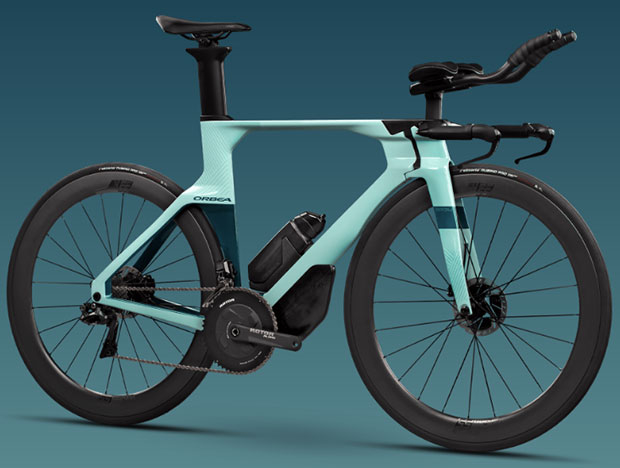
For Trek, that was in 2011, with the first-gen Speed Concept. Orbea took an approach similar to Trek, went back to the drawing board, reimagined what a tri bike should be by looking at the imperatives associated with the use of that bike – fit, storage, weight, aerodynamics, ergonomics, cosmetics, likely tire size, pricing & value – and then built the bike from scratch. This is what Cervelo did with its P5 Disc and the PX bikes. I think this is the only sound approach nowadays.
I have a bike coming to me, which I will sniff and noodle, ride for a bit, and then send back. Then I’ll be able to write a more granular and one hopes helpful review. But I did sit with the Orbea folks for about 90 minutes, listening about this bike, asking questions, looking at the details, and I’ll tell you what my first impressions are.
Pricing & Value
The price points are US $9,000, $7,000 and $5,000. Nothing very entry level, however it is notable that you get all the sexy frame features at that $5,000 price. As I write about the frame features, bear this in mind. At $5,000 you’re getting a frameset that isn’t usually featured at a price like this, notably the front end, and the handlebar adjustment scheme. That $5,000 bike is not horribly down-specd. It’s an Ultegra 8000 mechanically shifted bike.
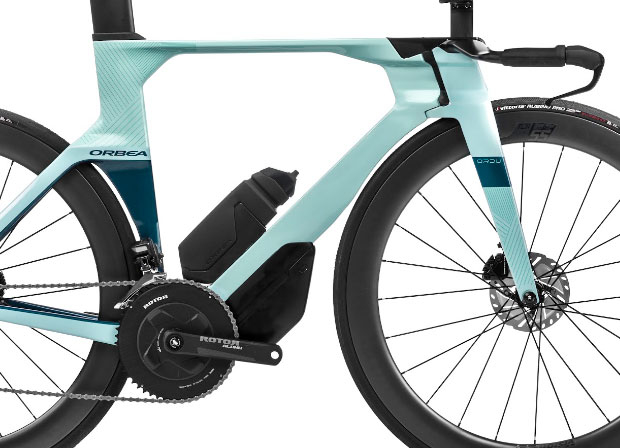
Just, realize that you’d sell this bike short by comparing it to other Ultegra bikes. How about if you look at it this way: What is the price of other bikes that have a seat post style front handlebar adjustment scheme? Then the value in this bike starts to look pretty good.
The higher-end builds are Shimano Dura Ace and Ultegra Di2 electronic bikes respectively.
Storage
I am not a fan of proprietary down tube aero water bottles, whether Cervelo’s or Orbea’s or anyone else’s. My guess? I will immediately take this bottle and cage off the bike (this isn't where I keep my hydration). There is no built-in top tube storage or handlebar hydration system I can see, which does not bother me, but I will certainly put these on the bike, so, were the aerodynamics designed with my use in mind? If you’re not deploying hydration and storage above the waist of your tri bike, then you and I look at the world through different goggles.
I do like that seat tube nacelle. I like storage low; that is featured inside the aerodynamic scheme of the bike; and that is large enough for my stuff. This is a part of why I like Cervelo’s P3X, and the front-end sliding “stem” and the down tube nacelle are two good P3X ideas that got appropriated for this new Ordu.
Fit & Geometry
Pay no attention to the stack and reach numbers published for this bike, if you can find any published. Orbea has either omitted any mention of these metrics, or it has chosen to site the distal point, where stack and reach are measured to from the BB, at a point other where they are historically measured. Orbea is not the only company to ever do this, but this irks me, since words mean things; terms of art require attachment to adherence; and since I came up with these damned terms myself.
I will leave this aside, beyond the following admonition: Frame stack and reach terminate at the top of the head tube – absent any spacers or extenders – and follow the line of the steering axis. Period. Period. If you want to talk about pad stack and reach, then you have to put the word “pad” on there when you write about it. If you do so, you need to place – in an obvious spot, where we call all see it easily – where it is you measure to on the pad: center or rear.
There are 4 sizes to this bike, and Orbea has done what (according to memory) BMC has done with its Time Machine, which is to make 2 middle sizes, one of which has a low front end, the other high. I assume this is largely to placate pro cycling teams. I’ll talk about sizing more in the future.
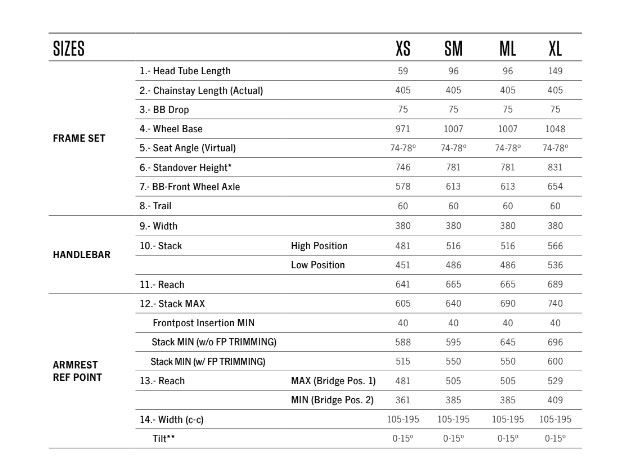
One pretty good tell about how these bikes will fit is the front center. It’s in that row that Orbea refers to as “BB to Front Wheel Axle.” You see that the FC measures, small to larger, are 578mm, 613mm, 613mm, and 654mm. The two middle sizes are the tall and short versions of a bike the same length. I ride a 56cm tri bike, or size L usually, size M in Canyon, and these are all bikes with FCs of 611mm to 625mm. FC and trail will go along way toward telling me how the bike will handle, so, a bike with 60mm of trail and 613mm of FC is pretty much in my wheelhouse, and there is an Ordu is made for my use.
Orbea has produced a min and max “stack” and “reach”, by which it means pad(!) stack and reach, and were it not for the fact that I’ve been forced out of my home and office by California’s wildfires – this displacement causing me a lot of hassle – I would have built you all a Cartesian fit chart showing how adjustable and in what dimensions each of these frame sizes will adjust to (and nested it in this overview). I’ll get around to it, unless Orbea does it first (Orbea made such a chart for its last Ordu, so, it knows what I’m talking about, and maybe it’s done this already and I just haven’t seen it).
The fit ranges are wide, with about 120mm of length between the closest and furthest armrest position, about around 100mm of height. Badly designed superbikes limit adjustment range, versus the range available in mortal tri bikes (with standard stems and clip on aerobars). Well designed superbikes expand the fit range. This one, at first blush, seems to expand the adjustment range. I have selected certain metrics and presented them above.
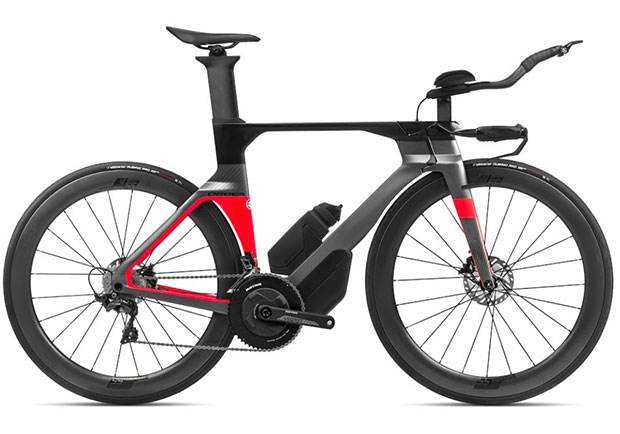
The aerobars tilt, as you can I hope see, which makes possible the newer style of fitting chosen by certain riders which consists of (perhaps) raising the pads slightly, and tilting the aerobars up. If you offer 15° of possible tilt, as a bike maker, you’re usually able to accommodate this sort of positional theme.
The extensions are of a wrist-relief style, provided by Vision, tho Orbea makes its own brackets and pads.
The bike is, as you might expect, built with disc brakes. The frame is designed to accommodate 28mm tires, and it seems to me both Cervelo and Orbea assume that this is the tire size to which you may well eventually migrate, and I think that’s a pretty good wager.
And that’s it! For now. The bike should be available now, and is available through local bike shops (as is the case with, say, Cervelo, Trek, Specialized). I think the launch of this bike is about right on the calendar, if we assume that racing will resume in earnest by, say, Q2 of 2021. This gives you a chance to buy the tri bike you’ve been holding off on getting, with enough time to get used to it before your target events.
I’ll write more once I’ve gotten the bike, put it through Slowman’s routine, and can write with firsthand experience. Also, I will discuss this bike with Andrew Starykowicz, who I assume is aboard one of these already (or if not soon will be), and who is notoriously unlikely to blow smoke up my bib shorts whenever I ask his opinion!
You can read more about the new Orbea Ordu, which includes information beyond what I’m writing about here.


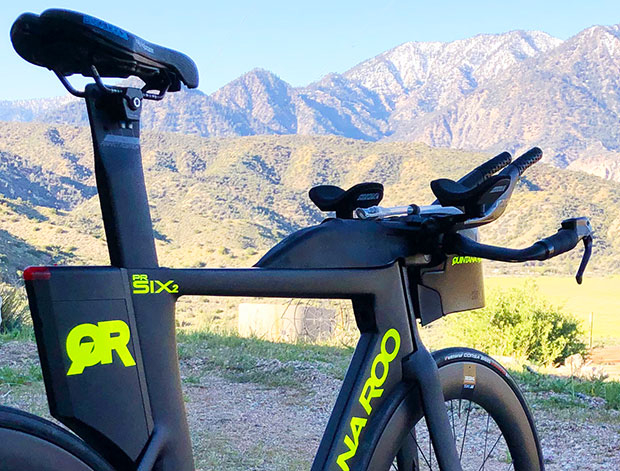
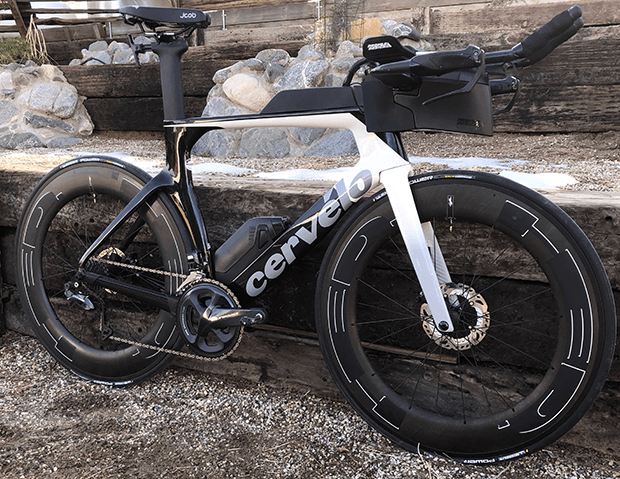
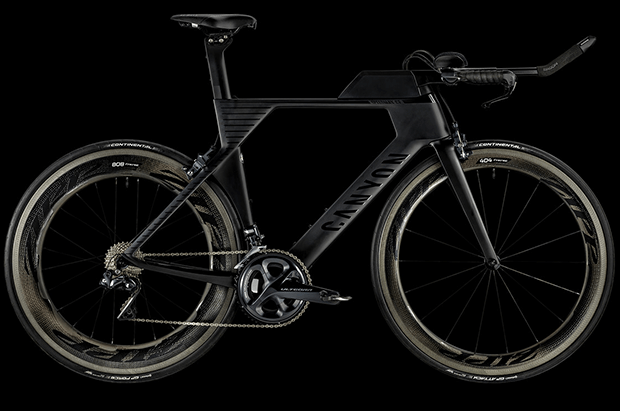
Start the discussion at slowtwitch.northend.network